6 Best Kettlebell Swings Alternatives with a Resistance Band
Are you looking for ways to target and strengthen your posterior (back) side?
I’m talking about the muscles around the spine, as well as the traps, glutes, hamstrings, and calves – everything from the neck to your heels. Also known as the posterior chain.
Well, say hello to kettlebell swings!
These killer exercises are like magic for those muscles.
Trust me, as I’ve gotten older, I’ve learned to love working on these areas.
Why? Well, as we age, our posterior muscles can start to weaken and sag.
Ever notice your shoulders slumping forward or your once perky bottom being, well, not so perky anymore?
That’s a sign it’s time to give the posterior chain some extra love.
Not only does strengthening these muscles make a big difference in how we look, but they also play a major role in keeping our posture and stability on point.
This helps make activities such as bending over, standing up, sitting down and just standing tall much easier.
But what if you don’t have access to kettlebells or weights, or you’re looking for cheaper alternatives to this equipment that is also gentler on your low back and shoulders?
Don’t worry, my friend. There are plenty of effective ways to target those same muscles without kettlebells or free weights.
Personally, I’m obsessed with resistance bands – I’ve got an entire collection!
In this article, I’ll share exercises that’ll help you keep that sexy posterior chain in tip-top shape using resistance bands and bodyweight moves.
Ready to dive in and keep moving, looking good, and feeling fabulous?
Let’s go!
This post may contain affiliate links. As an Amazon Associate, I earn from qualifying purchases. This means I may earn a commission at no extra cost to you should you choose to make a purchase using my link.
The Advantages of Resistance Bands Compared to Kettlebells
As I’ve gotten older, I’ve found resistance bands to be kinder to my joints compared to kettlebells.
Full disclosure, I do use both kettlebells and resistance bands for different exercises. This is just a personal preference – but I can assure you that using resistance bands and body weight will get the job done!
Kettlebells require increasing weight for effectiveness over time, and this increase can put more stress on the joints due to the jerking motions.
This jerking can be challenging and has caused me some low back and shoulder pain.
Then there is always the expense of buying heavier kettlebells!
Resistance bands are much gentler on my muscles, tendons, and ligaments and definitely easier on the budget.
If you’re like me and want to work out for as long as your body allows, it’s crucial to find ways to avoid pain and injury.
Injuries can cause you to be less motivated and make you want to stop exercising altogether.
Can you perform exercises like kettlebell swings using resistance bands? Absolutely!
I’ve discovered several methods to work the same muscle groups while putting less stress on my joints and reducing pain. Here are a few points to consider:
- Gentler on joints: Resistance bands’ elastic nature provides a smoother, more fluid range of motion, reducing joint strain.
- Versatility: They can easily and effectively replicate kettlebell exercises with slight adjustments, allowing for a diverse workout.
- Portability: Resistance bands are lightweight and compact, making them an excellent choice for workouts at home or on-the-go.
My personal experience has shown that resistance bands can be a fantastic alternative to kettlebells by providing a joint-friendly and versatile workout.
So, if you haven’t tried resistance bands yet, I suggest giving them a shot!
6 Alternatives to Kettlebell Swings
Here are 6 of my favorite exercises to do instead of kettlebell swings to work the posterior chain.
1. Resistance Band Pull Throughs
I really enjoy Resistance Band Pull Throughs because they’re similar to kettlebell swings but without putting extra strain on your shoulders.
For this exercise you can use therabands, loop bands, tubed bands with handles or pull up assist bands.
Let me share how to do this exercise effectively:
- Secure the band: Attach your resistance band to a sturdy stationary object close to the ground.
- Get in position: Stand with your feet slightly wider than hip-width apart and hold the resistance band with both hands between your legs.
- Adjust distance: Move away from the anchor point until the band is taut but not stretched.
- Engage your core: Keep your core tight and your knees slightly bent.
- Hinge and push back: Push your buttocks back a little and hinge at the waist, positioning the band behind your thighs.
- Pull and stand: Pull the band in front of you as you stand up quickly, engaging your glutes as you straighten.
- Repeat the process: Return to the bent position and continue for the desired number of repetitions.
By keeping your arms below shoulder level during this movement, you avoid any unnecessary jerking or stress on your shoulders while still getting the benefits of a smooth, full-body workout.
2. Standing or Kneeling Kickbacks Using a Resistance Band
If you’re looking for a great way to strengthen your hamstrings and buttocks Kickbacks are a great option!
If a stationary object isn’t available, you don’t need to anchor your band because this exercise can be done standing or kneeling.
You can choose between loop bands, flat therabands, or tubed bands – they all are great options.
Here’s how to perform the exercise:
- If standing – place a resistance band around a stationary object.
- If kneeling – place the resistance band under your right knee and hold the end with your right hand.
- Place your left foot in the resistance band.
- Engage your core and bend your left knee.
- Then, push back with your left foot and fully extend your left leg.
- Squeeze your glutes.
- Return to the starting position, and repeat.
You’ll mainly feel the burn in your glutes and hamstrings, but this exercise will also target your core.
Keep up the great work!
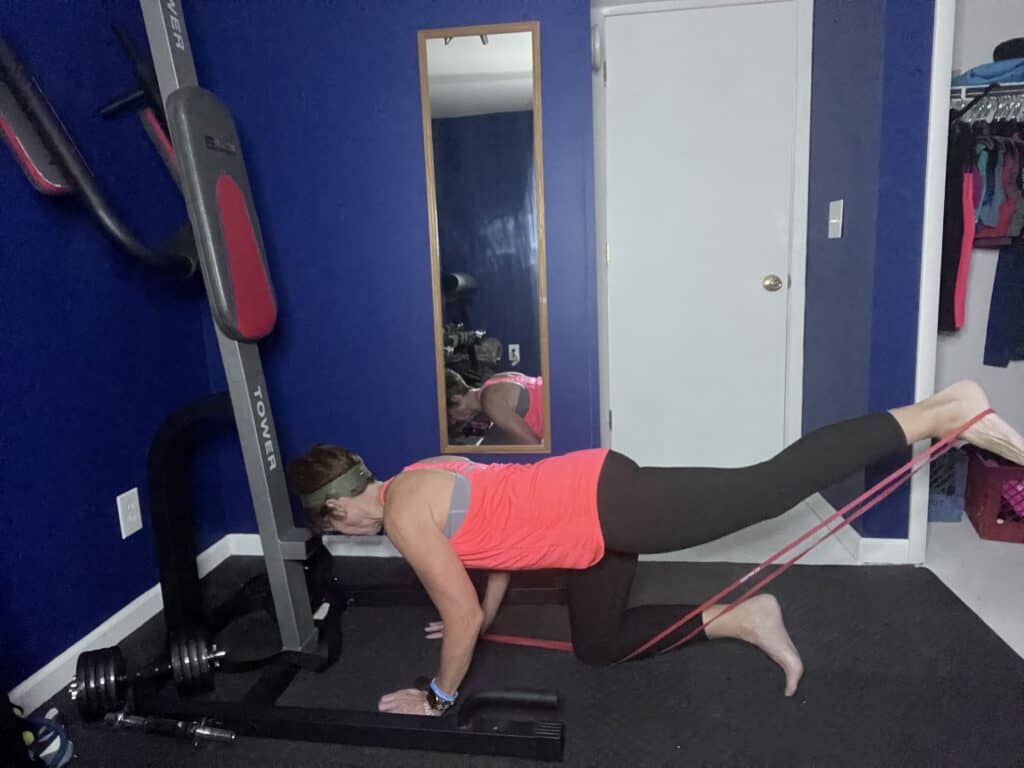
3. Good Mornings
Good Mornings is a straightforward yet powerful exercise that benefits all muscle groups in the posterior chain.
I prefer using a loop band for this one, but again, any of the other bands can also work.
To perform this exercise:
- Stand with a resistance band under my feet, a little more than hip-width apart.
- Loop the other end of the band around my shoulders, holding onto either side.
- Keep my core tight and my knees slightly bent.
- Gently push my butt back and hinge at my waist.
- Stand back up and squeeze my glutes.
- Then, return to the bent position and repeat.
Enjoy this fantastic exercise!
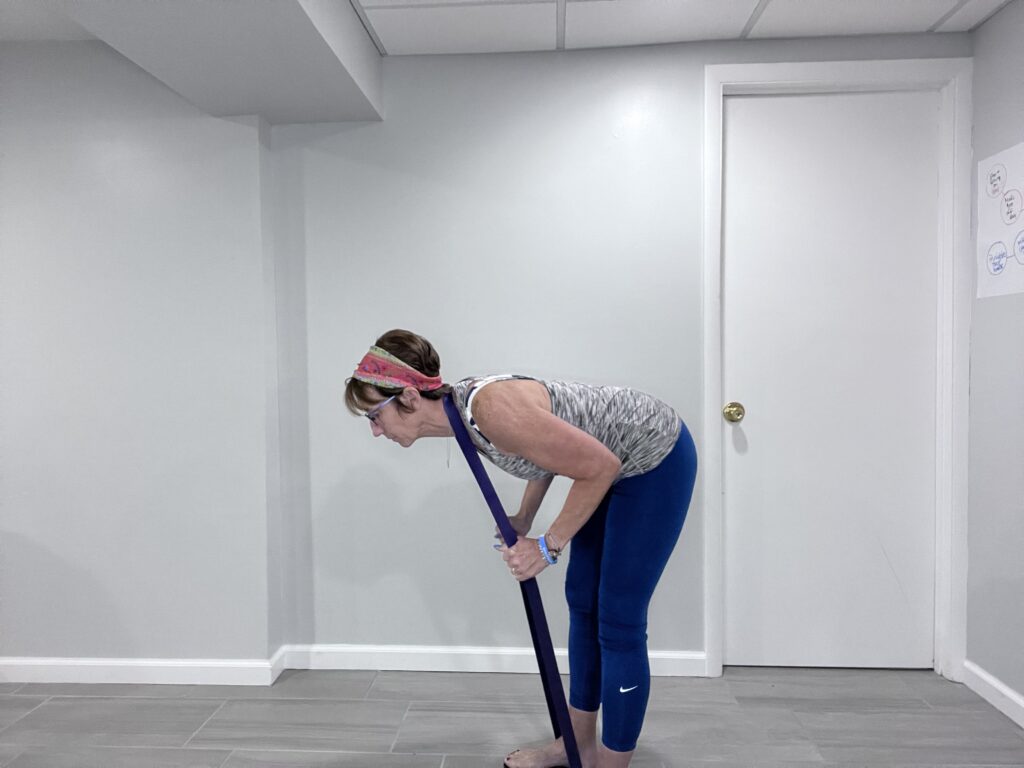
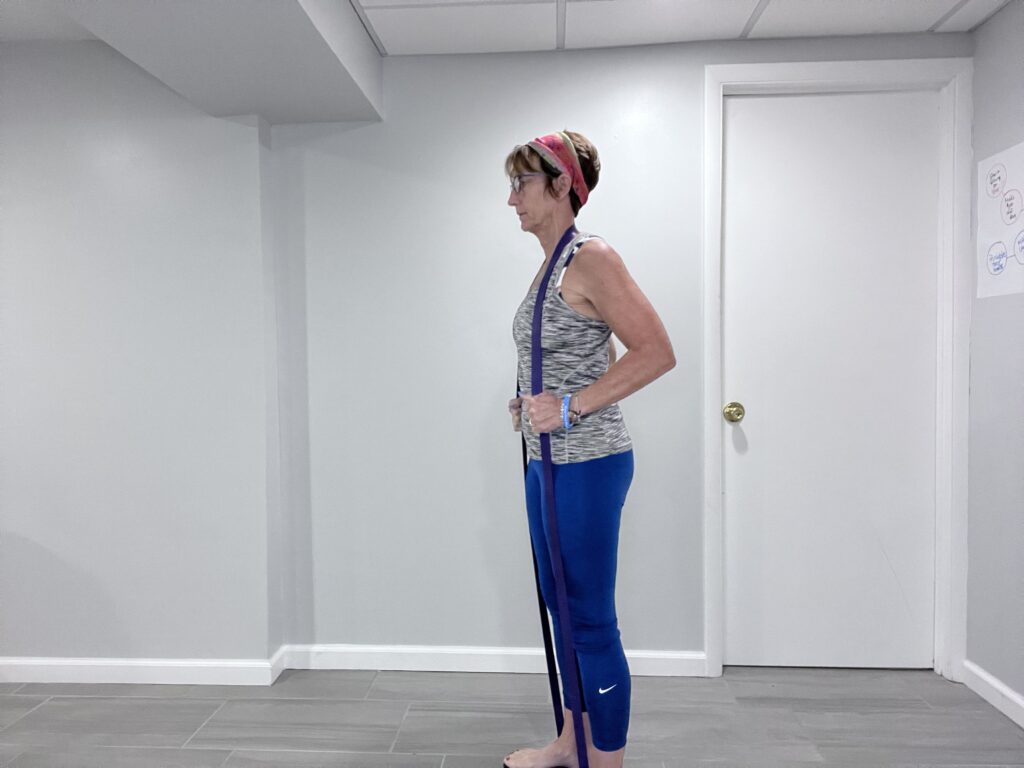
4. Glute Bridges
I find glute bridges to be an excellent exercise for working the posterior chain. For this workout, you can use a booty band, mini loop band, or a flat theraband tied around your legs.
Make sure to place the band just above your knees – never right on the knees – to avoid injury.
Here’s how to perform the exercise:
- Lay flat on your back
- Bend your knees, positioning your heels close to your buttocks
- Lift your buttocks while keeping your back straight
- Push your knees outward, resisting the band’s tension
- Hold for a few seconds
- Lower your buttocks back to the floor and repeat
By engaging in this exercise, you’ll find that it targets multiple muscle groups for an effective workout.
And remember, always maintain a friendly tone, as indicated in the instructions.
5. Standing Calf Raises
Including calf raises with resistance bands and elevated steps into your workout routine is sure to strengthen and tone your calves.
This exercise can be done with or without a resistance band.
If you do use a resistance band, you may want to use a large loop band or theraband.
Here’s how to perform a calf raise with resistance bands:
- Grab your resistance band and something to elevate your heels, such as a stair or a yoga block.
- Set the elevated surface directly underneath your hips.
- Step onto the elevated surface, placing the balls of your feet on the edge. Your heel should hang off the edge.
- Stand tall with an upright posture.
- Place the resistance band under the balls of your feet. Hold the other end of the resistance bands in your hands.
- Make sure your knees are locked out and your entire leg is contracted as you press the balls of your feet into the stair or block to lift your heels as high as possible while keeping straight legs.
- Pull the resistance band up as you raise your heels.
- Pause at the top for 2 seconds and then begin to slowly lower back down.
- Keep pressing the balls of your feet into the stair or block as you feel your calves stretch and lower down.
- Repeat for 10-15 reps.
Remember to keep a friendly attitude during the workout and enjoy the process of strengthening your calves.
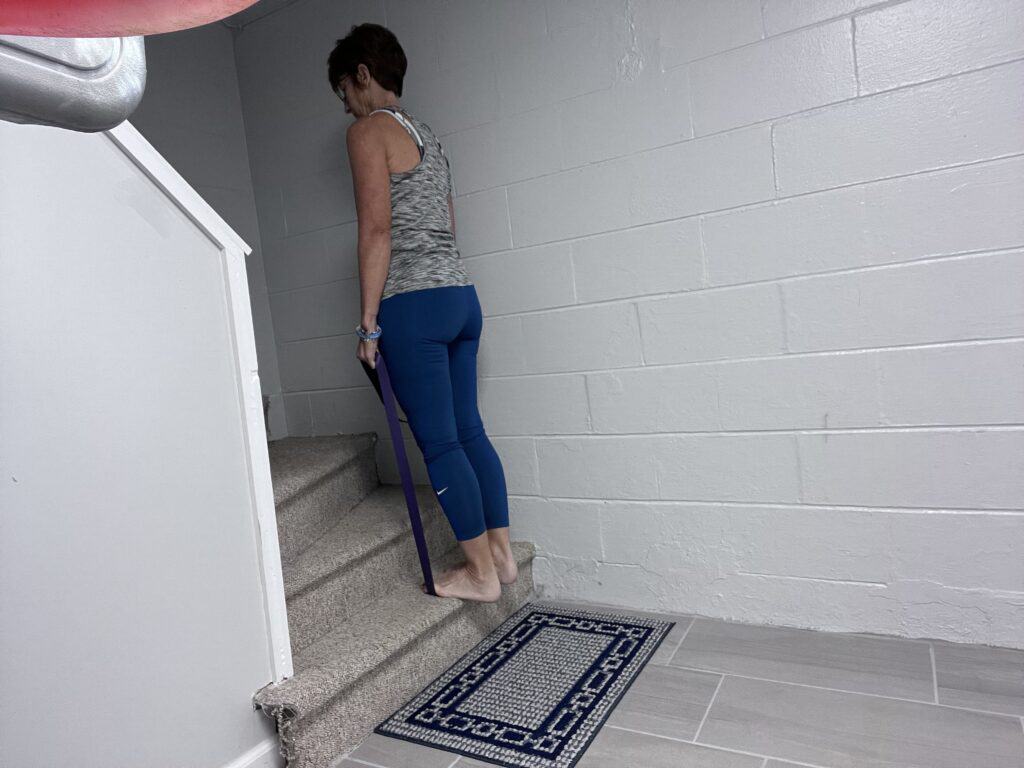
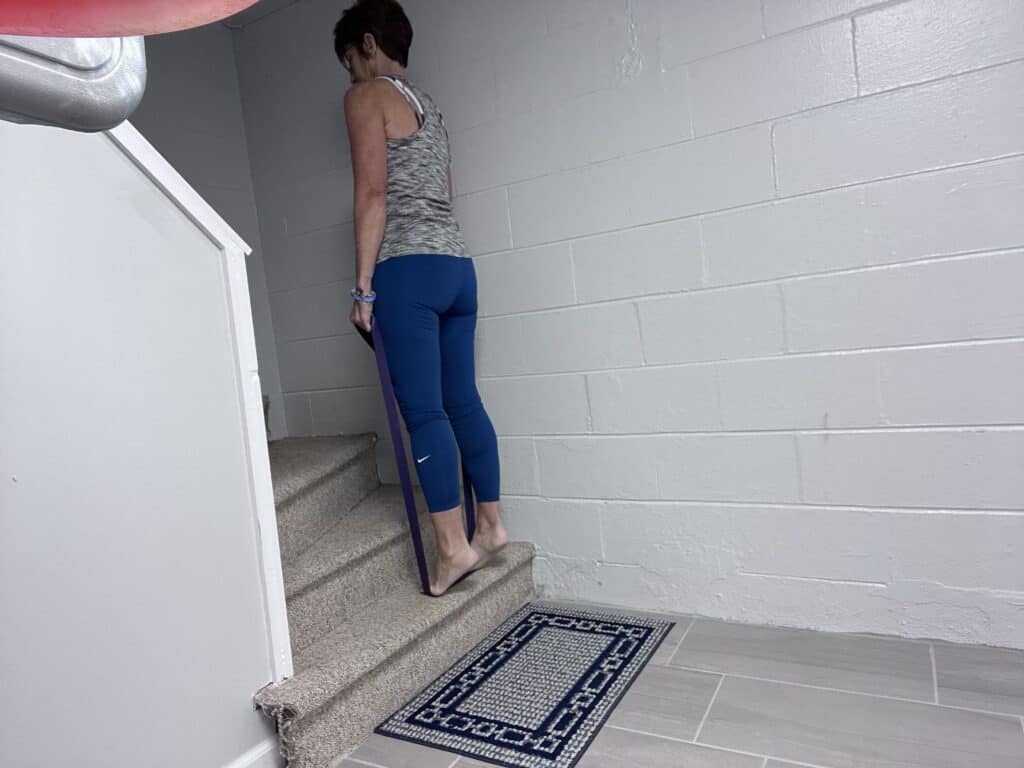
6. Band Pull Aparts
Band Pull Aparts are extremely effective when working upper back and mid back muscles.
To do this exercise:
- Grab both ends of the resistance band and hold it up by your chest.
- Keep your palms facing up toward the ceiling.
- Pull the band apart and out to the side without bending your elbows.
- Keep going until the front of the band touches your chest.
- Hold this for 2-3 seconds squeezing your upper back muscles together.
- Slowly release and repeat 10-15 times.
A Quick Recap
I’ve discovered that anyone can gain strength at any fitness level.
If traditional weights or kettlebells aren’t suitable, no worries!
I recommend trying resistance bands for an effective workout that’s gentler on joints, muscles, and tendons.
Just remember to adjust your fitness plan as needed, and most importantly, never give up on exercising!
